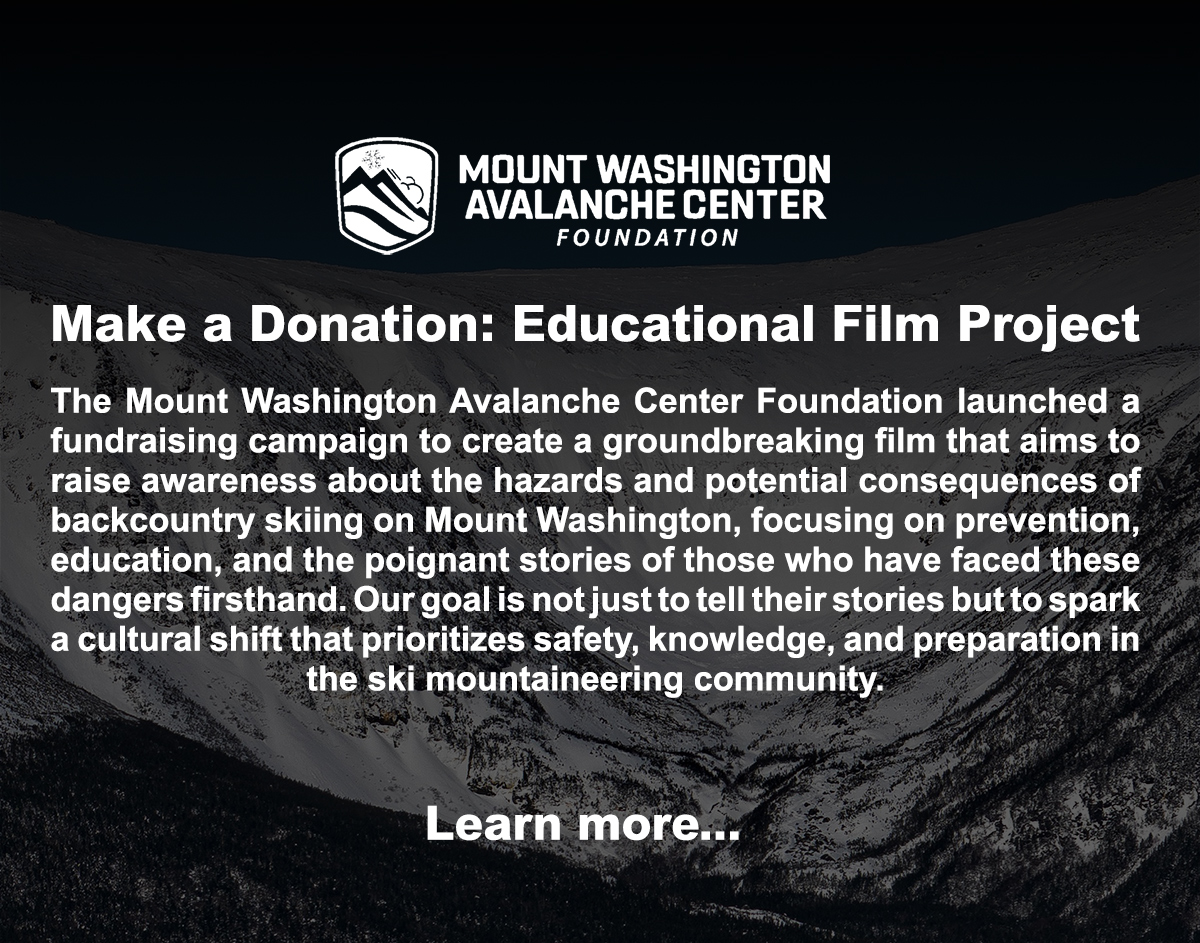
At just 6,288 feet above sea level, Mt. Washington, the high point of the northeastern United States, packs a very serious mountain into a diminutive package. Home of the so-called “worst weather in the world,” Mt. Washington clocked a wind speed of 231 mph in 1934, and hurricane-force gusts (greater than 74 mph) are observed at the summit more than 100 days a year, on average. The summit observatory has recorded temperatures as low as -50°F (-46°C), and an estimated wind chill of -102°F was recorded in January 2004.
Rising at the intersection of major storm tracks and forming a prominent barrier to winds from the west, Mt. Washington and the Presidential Range also receive heavy precipitation. Each season averages 280 inches of snow, and wind-blown snow can pile up to depths of 10 to 40 feet in the east-facing ravines. Yet warmer temperatures can also be a problem, as freezing rain and fog—prime hypothermia conditions—are frequently encountered.
Despite the weather, Mt. Washington draws thousands of adventurers every year for hiking, ski mountaineering, and ice climbing. The access is easy—just 2.5 miles of hiking or skinning from the Joe Dodge Lodge at Pinkham Notch bring you to tree line—and naturally some people get into trouble. According to the Mount Washington Avalanche Center, every year an average of 25 people require rescue assistance on the mountain. Nearly 150 people have died.
This article examines where and why climbing and skiing accidents occur on Mt. Washington and suggests a few steps to prevent them. Although some of these situations are unique to the Presidential Range, many of the lessons apply to mountains throughout North America. Our focus is on technical climbing (mostly in winter) and skiing, primarily in the dramatic bowls and chutes on the east side of the mountain. Ski activity peaks in the spring season and is centered on Tuckerman Ravine, known as the “birthplace of extreme skiing” in North America. Ice climbing is mostly in Huntington Ravine, to the north of Tuckerman, where multi-pitch gullies draw hundreds each winter.
We looked into the archives of both the Mount Washington Avalanche Center (MWAC) and Accidents in North American Climbing (ANAC). We reviewed 152 MWAC reports, from June 2019 back to the beginning of 1998. We also looked at 38 reports published in ANAC between 1978 and 2018. No accidents were duplicated in the various statistics presented in this article. However, each person injured or involved in a given accident was counted, so one report could generate multiple “incidents.” For this article, we only considered incidents that occurred at or above tree line, which is approximately 4,400 feet above sea level, just above the base of the great bowls on the east face. Some hiking also was examined. Normally, ANAC does not cover hiking incidents, but on Mt. Washington in the winter months, nearly all travel above tree line can be considered winter mountaineering.
WHEN AND WHERE
This is very much a story of the winter and spring seasons. Nearly 95 percent of the incidents we tracked occurred from January to May, with more than half of the total in March and April. With one or two exceptions, rock climbs on Mt. Washington are not popular, and there are relatively few climbing accidents in the summer and autumn months. (Hiking incidents occur throughout the year.)
Skiing and avalanche incidents peak in April, when the classic spring sliding in Tuckerman Ravine and the neighboring chutes draws hordes of people to brave the steep slopes and sunbathe and cheer from the floor of the ravine.
In and near Tuckerman Ravine, the three most frequent incident locations are the Lion Head winter trail, the primary summit route in winter conditions; Hillman’s Highway, a long chute left (south) of Tuckerman, very popular among skiers; and the Headwall/Lip area of the main bowl. The ski routes in Chute and the Right Gully also see many accidents.
In Huntington Ravine, Central Gully (an easy ice climb or snow climb—or a ski route in certain conditions) and Odell’s Gully (WI2/3) have seen the most accidents. The third most frequent location is below the climbs, on the snowy approach, especially on the fan, the snow-covered boulderfield that spreads below the main gullies.
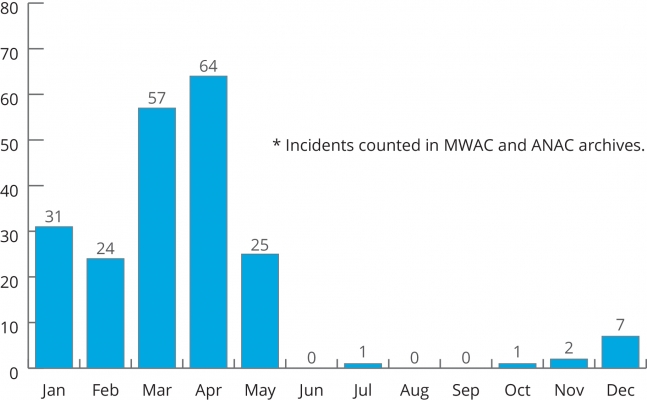
FALLS ON SNOW AND ICE
As with most climbing areas, the most common accidents on Mt. Washing- ton are falls—in this case falls on snow or ice. In Tuckerman Ravine, skier falls outnumber climbing and winter mountaineering falls. In Huntington, ice climbing accidents make up the majority, but falls on snow also are significant, especially on the fan.
A significant factor all over Mt. Washington is the presence of very hard or icy snow resulting from rain/freeze or thaw/freeze events. In such conditions, there may be widespread expanses of snow as hard and slippery as ice, and climbers or skiers who are not prepared with the necessary skills and equipment may suffer long sliding falls. Boulders and bushes below popular routes add to the hazard. The Lion Head winter mountaineering route has seen many accidents when hikers or climbers with inadequate winter boots or no crampons have fallen and slid into trees.
In many reported cases, people involved in falls were either not prepared for hard snow (e.g., they did not carry crampons or ice axes) or they left the necessary gear in the pack. Pull out your ice axe and put on crampons before entering steep, icy terrain. Other falls were the result of a failure to self-arrest or loss of control of a glissade. In March 2016, after a thaw/freeze event, a mountaineer glissading on the summit cone lost control and suffered a broken femur. Several skiing accidents have resulted from the failure to stop slides using self-arrest pole grips, such as Whippets. Self-arrest is not an intuitive skill—it must be learned and practiced regularly—and the climber or skier also must recognize the conditions in which it will not be effective. On icy 35° to 45° slopes, self-arrest is unlikely to succeed—it’s most important to avoid falling in the first place.
The time of day also plays a key role. As one MWAC accident analysis put it, “Spring skiing is all about timing. Start your day too early and the snow will still be frozen; end your day too late and your slope might turn to cement as you watch. A knowledge- able Tuckerman spring skier will follow the sun, often starting the day on east- or northeast-facing slopes, and slowly work their way across the bowl, ending the day on south-facing slopes that are catching the last of the sun’s rays…. Once a [sunny] slope goes into the shade, it can freeze almost instantly, necessitating the use of crampons on the way up and creating no-fall territory on the way down.”
Occasionally, falls happen when ice climbers delay roping up during their approach. In February 2016, for example, an inexperienced climber fell from low in Central Gully as the leader of the party coached the unroped climber up a short ice step below their planned rope-up spot. Note: If you do rope up, belays or running protection are essential; otherwise, a fall risks pulling off the entire party.
A somewhat surprising hazard, given that there are no glaciers in New England, is the formation of crevasses in the deep snowpack. Tuckerman Ravine develops bands of crevasses on and below the Headwall. In early April 2012, a man suffered a fatal accident when he slipped while descending into Tuckerman and slid into a crevasse; this party had ascended a different route and thus was unaware of the waiting crevasse hazard.
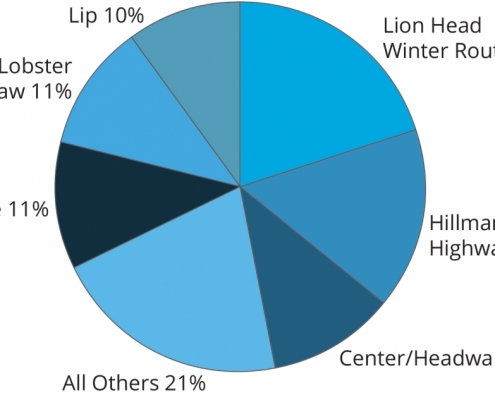
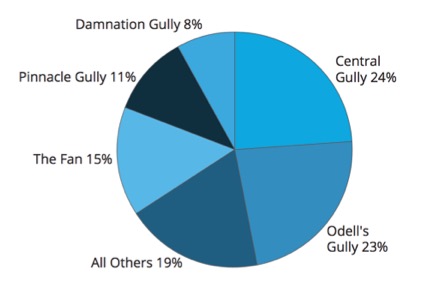
ICE CLIMBING FALLS
The weather and elevation on Mt. Washington allow for a long ice season, from mid-autumn well into spring. Although most of the climbs are not technically very difficult (up to WI3+), they are complicated by length and exposure to wind, cold, and extremely variable conditions. Climbers can expect ice to shatter and “dinner plate” in cold conditions. Conversely, ice dams may form in bulges, releasing sudden flows of water from tool placements. In 2001, Ned Green, caretaker of the Harvard Mountaineering Club cabin below Huntington Ravine, fell to his death after his soloing partner’s tool ruptured an ice dam above him in Damnation Gully.
Often, poor surface ice must be chopped away to find good tool and screw placements, and longer ice screws may be desirable for protection. In February 1986, a leader fall on brittle and poorly bonded ice in Pinnacle Gully ripped out the ice protection at the belay anchor and resulted in both climbers falling to the bottom of the route and then another 500 feet down the rock-studded Fan below.
A significant hazard on some climbs is the formation of wind slab in surface snow, and a number of ice climbing falls have been associated with small slides that pushed climbers off or caused them to lose their balance. In early March 2013, a climber fell to his death from the second pitch of Pinnacle Gully when he triggered a wind slab about 20 feet wide. Two similar incidents in Odell’s Gully have resulted in fatalities. Carefully assess the avalanche conditions on your particular route, on the day of the climb, before proceeding.
Placing an extra screw or two can help minimize the seriousness of some falls. In late December 1998, two experienced ice climbers were simul-climbing up Odell’s Gully when one snagged a crampon point on his clothing and fell, pulling the other off. The single screw between the two held them both, but one climber fell nearly 40 meters and was injured.
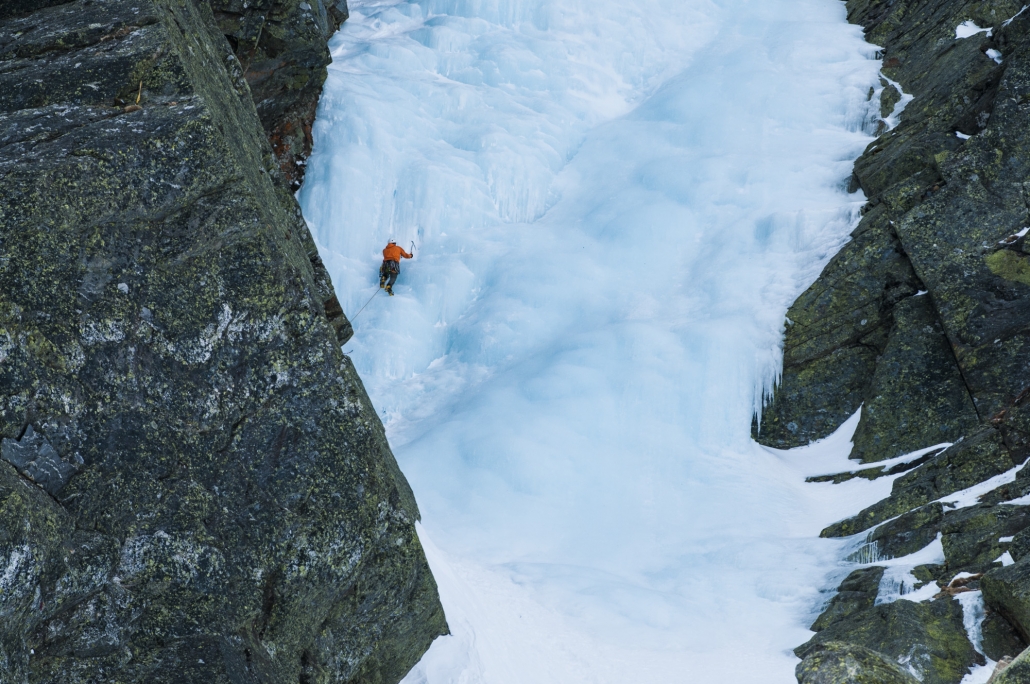
AVALANCHES
April is the peak month for reported avalanche incidents, despite a more stable spring snowpack—this is likely because more people are in Tuckerman Ravine that month. Winter-like storms can deposit significant fresh snow and form dangerous conditions throughout the ski season (i.e., well into May). The archives show that January was the second-highest month for avalanche incidents. Midwinter skiing activity in the ravines has increased significantly in recent years.
A majority of avalanches involve skiers, but climbers and hikers also get caught, especially in the area where winter routes pass near the top of Tuckerman Ravine and in locations all over Huntington Ravine. Most of the reported avalanches were triggered by people, not naturally occurring.
A complicating factor on Mt. Washington, especially in the spring, is large crowds of skiers. This can cause multiple parties to be in the path of any avalanche that is triggered. The crowds and party atmosphere also may encourage poor decision-making and heuristic traps, including the “social proof” trap (“All those guys skied it, so it’s got to be OK.”)
The recommended avalanche and weather forecast for climbers and skiers is posted at mountwashingtonavalanchecenter.org throughout the winter and spring seasons; detailed weather forecasts for the summit are posted at mountwashington.org. Winter travelers should read forecasts carefully and then make informed decisions without following others into trouble.
Note that in our examination of the MWAC archives, more avalanche incidents occurred when conditions were rated “Moderate” than when they were rated “Considerable” or “High.” A rating of “Moderate” indicates “heightened avalanche conditions on specific terrain features. Given the complexity and steepness of Mt. Washington’s terrain, skiers and climbers must evaluate each slope or gully individually.
Another concern is that many climbers and even many skiers do not carry beacons or avalanche rescue gear, and many also do not have adequate avalanche training. In January 2016, a slide in the Chute caught five climbers and skiers, none of whom were wearing beacons or carrying probes and shovels. As the MWAC report for this incident said, “Avalanche gear may or may not save your life should you get caught, but it certainly won’t help you if it is in your closet.”
WEATHER AND NAVIGATION
Given the extreme weather on Mt. Washington, the number of hypothermia and frostbite cases in the archives is surprisingly low, although storms, whiteout, and disorientation have led to a number of high-profile fatalities or loss of limbs from frostbite. It’s also likely that some frostbite cases are not reported, and that storms often result in “near misses” that easily might have become much more serious.
Anyone venturing above tree line on Mt. Washington—especially those planning to travel above the ravines on the Alpine Garden or summit cone—should prepare for extreme wind chill with windproof gloves or mittens (and extras in the pack), a face mask or balaclava, and goggles, in addition to the usual winter clothing. The equipment (GPS and/or map and compass) and skill for navigating in a complete whiteout are also necessities. A frequent challenge arises when layers covering the face lead to foggy goggles freezing over, rendering them useless; consider carrying spares.
Climbers exiting the ice routes in Huntington Ravine are vulnerable to sudden exposure to foul weather. Study the descent options before a climb, especially the Escape Hatch route, which allows a quick descent from the south rim. (Be aware that ice and avalanche hazard may exist in this gully.) Though not as easy, scrambling down from routes on the north side of Huntington may be much safer than attempting to traverse the Alpine Garden to the south. The ability to construct V-thread rappel anchors will allow you to bail directly down certain routes.
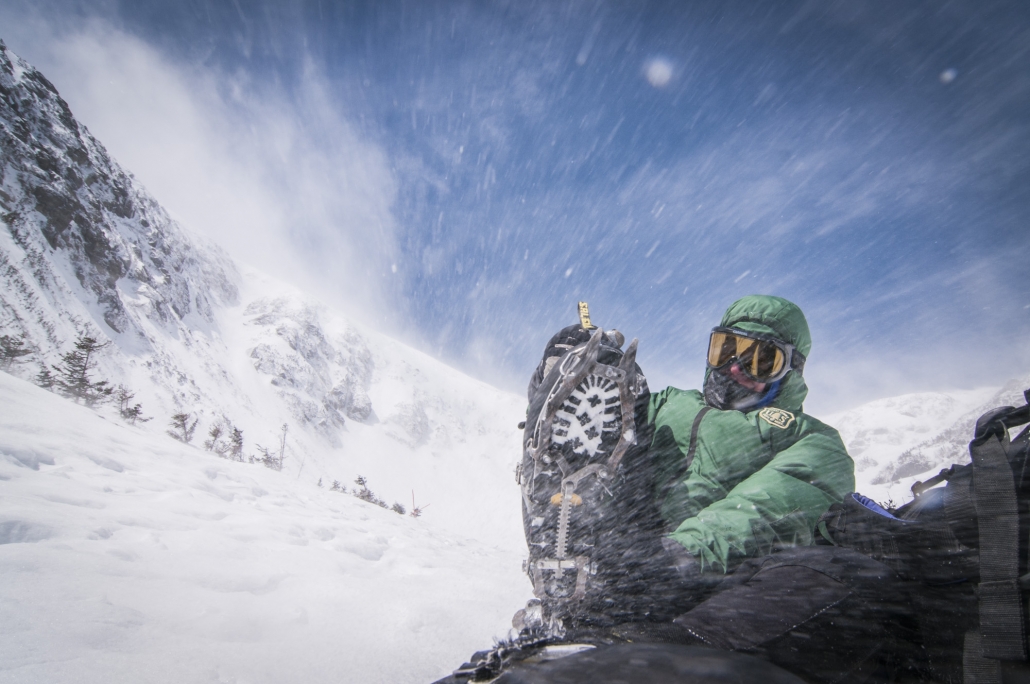
EXPECT ANYTHING
Many incidents on Mt. Washington involve a combination or accumulation of factors: a sudden whiteout leading to stranding and frostbite; a slow climb resulting in a descent in darkness, which ends in avalanche terrain. In one tragic example from February 1979, two young ice climbers finished Odell‘s Gully and continued up the snow above. The weather was terrible, with temperature of -20°F and wind up to 100 mph. Near the top of the Pinnacle, the two dug a snow hole to take shelter. The next day they attempted to rappel but were forced to abandon their rope (presumably it was stuck), and they tried to continue down on foot. Both fell to their deaths. Autopsies showed both had frozen hands and feet before their desperate attempt to descend.
Especially for newcomers to the mountain, a conservative approach is recommended. Conditions above tree line are always much worse than down in the forest. Turn back before things get really bad.
Before and during a trip to Mt. Washington, climbers and skiers can benefit from many information sources: real-time observations from the staffed observatory at the summit; Forest Service snow rangers who write a daily avalanche forecast and patrol the mountain in winter and spring; the caretakers at the Appalachian Mountain Club and Harvard Mountaineering Club huts; and a volunteer ski patrol. Good information is available—it’s up to climbers to seek it out and make prudent decisions.
Many of the factors that make Mt. Washington so hazardous also make this an attractive place to learn the skills needed for much higher mountains. The best way to accumulate such knowledge is to climb or ski with experienced mentors. If you don’t have access to friends with these skills, consider hiring one of the many professional guides in the area—it’s an investment that will make the most of your time on one of North America’s great peaks.
